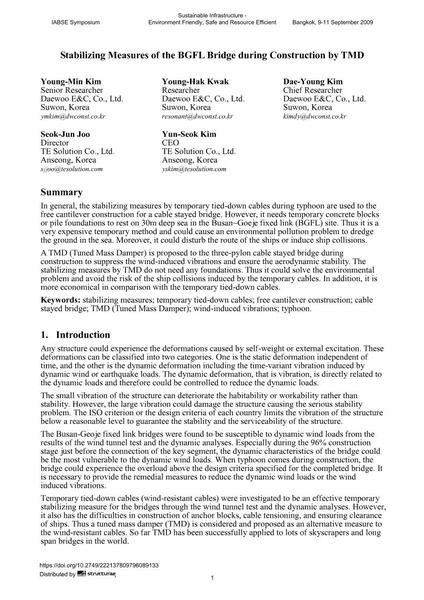Stabilizing Measures of the BGFL Bridge during Construction by TMD

|
|
|||||||||||
Détails bibliographiques
| Auteur(s): |
Young-Min Kim
Young-Hak Kwak Dae-Young Kim Seok-Jun Joo Yun-Seok Kim |
||||
|---|---|---|---|---|---|
| Médium: | papier de conférence | ||||
| Langue(s): | anglais | ||||
| Conférence: | IABSE Symposium: Sustainable Infrastructure - Environment Friendly, Safe and Resource Efficient, Bangkok, Thailand, 9-11 September 2009 | ||||
| Publié dans: | IABSE Symposium Bangkok 2009 | ||||
|
|||||
| Page(s): | 20-27 | ||||
| Nombre total de pages (du PDF): | 8 | ||||
| Année: | 2009 | ||||
| DOI: | 10.2749/222137809796089133 | ||||
| Abstrait: |
In general, the stabilizing measures by temporary tied-down cables during typhoon are used to the free cantilever construction for a cable stayed bridge. However, it needs temporary concrete blocks or pile foundations to rest on 30m deep sea in the Busan~Goeje fixed link (BGFL) site. Thus it is a very expensive temporary method and could cause an environmental pollution problem to dredge the ground in the sea. Moreover, it could disturb the route of the ships or induce ship collisions. A TMD (Tuned Mass Damper) is proposed to the three-pylon cable stayed bridge during construction to suppress the wind-induced vibrations and ensure the aerodynamic stability. The stabilizing measures by TMD do not need any foundations. Thus it could solve the environmental problem and avoid the risk of the ship collisions induced by the temporary cables. In addition, it is more economical in comparison with the temporary tied-down cables. |
||||
